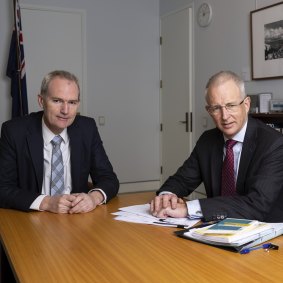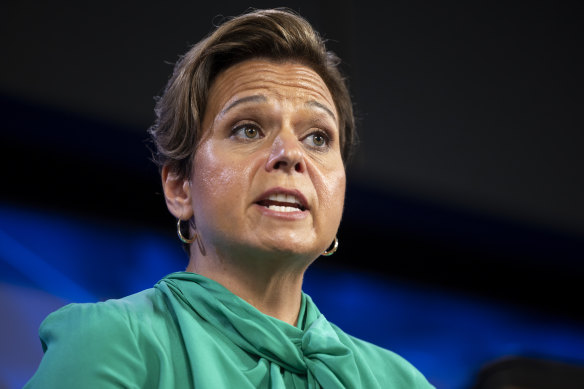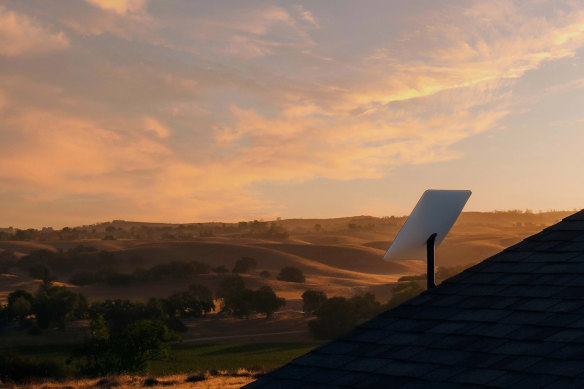A faster NBN is set to deliver a $400 billion boost to Australia’s economy by 2030
“The NBN has proven to be the great equaliser and the great enabler. It is delivering a paradigm shift in how we work, access education and essential services such as healthcare and mental health support.
“It also has the power to unlock the great conundrum of the Lucky Country: a massive land mass that is, for the most part, sparsely populated. With population growth, our cities are becoming more congested. But thanks to the ubiquity of fast, reliable broadband, we are starting to see a gradual decentralisation of our population and workforce as people search for, and achieve, a better lifestyle in regional Australia.”
Statistics published by NBN Co show that thousands of Australians shifted to other options like Starlink over the past two months.
The network is facing unprecedented competition, however, particularly in regional Australia as consumers increasingly switch to cheaper or in some cases more reliable options including mobile hotspots and Elon Musk’s Starlink satellite internet system.
Statistics published by NBN Co show that thousands of Australians shifted to other options over the past two months.
The statistics show 7,157,136 ‘brownfields’ premises were activated on the NBN as of January 18, 2024, compared to 7,172,704 on October 26, 2023, a drop of around 15,000. The term brownfields refers to pre-existing premises, as opposed to new buildings.
A key threat to NBN market share is Starlink, a satellite system owned by Elon Musk’s SpaceX, which uses a constellation of thousands of low-orbit satellites to connect people in remote areas around the world including most of Australia. It was launched in Australia in 2021 and offers unlimited data for $139 per month along with a hardware fee of about $599, with speeds comparable to that of NBN’s 100-megabit plans.
The NBN also remains a political football in Canberra, as it has done for the past decade. Debates persist around pricing despite the network build itself being effectively finished. NBN Co is now focused on a speed upgrade program, rolling out 80,000 kilometres of new fibre and boosting the speeds of its fixed wireless product.
In October last year, Australia’s competition and consumer watchdog signed off on changes to wholesale NBN pricing which cut prices for the highest and lowest speed plans and raised them for the 50-megabit plan, which is used by about 45 per cent of Australians.
Those changes have caused a growing number of customers to ditch the NBN altogether, according to the opposition’s communications spokesman David Coleman.
NBN Co is also under pressure to keep most Australians connected to the network so it can generate a commercial return. There are currently around 8.6 million active premises on the network nationally.

Coalition’s communications spokesman David Coleman and shadow minister for the digital economy Paul Fletcher.Credit: Alex Ellinghausen
“The NBN is losing customers at an alarming rate. 2023 was the worst year for the NBN in its history, with tens of thousands of Australian families getting rid of the service,” Coleman said.
“Last year’s price increase was deliberately designed to increase prices the most on the lowest cost plans. So in a cost of living crisis, the Albanese government is deliberately increasing prices the most on the people who can least afford it.
“The response of many people has been to get rid of the NBN. Labor can’t credibly argue that it is managing the NBN well when so many Australians are abandoning it.”
Both NBN Co and the federal government said those claims were untrue.
An NBN Co spokesman said that it was not unusual to see modest fluctuations in the number of premises connected to the network.
“We continue to add tens of thousands of new customers to the NBN network every year, both in existing homes and business premises, and in new developments where we are rolling out new fibre,” the spokesman said.
“We are also seeing a very promising and positive response from customers that are keen to upgrade to full fibre connections and our highest speed tiers, with approximately 7000 upgrade orders every week.”
Communications minister Michelle Rowland said that the new pricing agreement has slashed wholesale prices on five out of six NBN plans, including on the two lowest-cost plans.
The 50-megabit plan has an effective increase of 2 per cent, which comes in well below inflation, she said.
“In comparison, David Coleman’s Coalition government submitted a pricing proposal before the last election that would have slugged working families with wholesale price hikes of inflation plus three per cent on some products. The Albanese government put a stop to that plan and got a better deal for Australian consumers and small businesses.
“Much like their ridiculous decision to roll out copper and then backflip to fibre, NBN pricing under the Coalition was a masterclass in economic and financial incompetence”.

Communications Minister Michelle Rowland says the new pricing agreement has slashed wholesale prices on five out of six NBN plans.Credit: Alex Ellinghausen
For Phillip Britt, the managing director of ASX-listed internet provider Aussie Broadband, the NBN will play a crucial role in Australia’s network infrastructure whichever party is in power.
“As someone who still calls rural Australia home, the need to provide regional Australians with stable, accessible and affordable internet was ultimately what got me into the world of telecommunications,” he said.
“It goes without saying that the NBN isn’t perfect, and we’re seeing that with the headaches that fixed wireless has continued to pose. That said, the NBN has remained a pillar of support across a land as big as ours, one where connectivity and the need to stay connected has never been as crucial as before.”
Fixed-line refers to NBN connections that use physical wiring to connect a home or business, while fixed wireless relies on data transmitted over radio signals.
NBN has faced regular criticism for its fixed wireless product, which serves around 750,000 homes and businesses and typically offers speeds up to 75 megabits, far lower than fixed-line services, which are used by the majority of Australians. In response, NBN Co is proposing to launch two new high-speed fixed wireless speed tiers from mid-2024.
Fixed-line refers to NBN connections that use physical wiring to connect a home or business, while fixed wireless relies on data transmitted over radio signals.
While satellite and mobile offer strong alternatives to the NBN, they cannot carry the same bandwidth load of the NBN or a similar fixed line technology, according to Britt.
“Ultimately, there are trade-offs with all offerings. We know that fixed-line technologies will always be the optimal infrastructure for our connectivity needs. Fortunately, NBN’s fibre upgrade program has been helping to alleviate some of that digital divide in recent years. Could more be done though? There’s no doubt about that.”
Loading
ACCAN is the consumer group representing Australia’s phone and internet users. Its deputy CEO Gareth Downing said that from a consumer perspective, the floor price for NBN plans is still too high.
He pointed to consumer research commissioned in 2023 by ACCAN that found 92 per cent of consumers believe telecommunications companies should provide an affordable internet plan, and separate research that found low-income households spend a larger portion of their budget on telecommunications than do higher-income households.
“Given increasing cost of living pressures, we consider that the need for a low-cost product has never been higher,” Downing said. “A higher wholesale price means a higher monthly bill for broadband consumers on NBN services.”
ACCAN itself has also yet to secure a funding agreement, Downing said, stifling its ability to argue for lower prices and leaving consumers effectively without a seat at the table.
“To help reduce wholesale costs over the long term, it is critical for consumers to have a voice in the regulation of NBN Co. At present there is no funding or resourcing for us to sufficiently engage with factors such as capital or operating expenditure, both of which are essential to determining the service quality and price that consumers eventually face,” he said.
“This is critical given that NBN Co is forecast to recover tens of billions of dollars in revenue from customers between now and 2040. Ensuring that money is well spent – and provides value for consumers and small businesses – requires genuine engagement which can only occur if there are appropriately resourced consumer representative groups at the table to represent the consumer interest.”
For NBN boss Rue, NBN Co is delivering on its promise of lifting Australia’s digital capability.
“By working to close the so-called digital divide through the delivery of ubiquitous broadband we are helping to improve social and economic participation, which is delivering positive social equity outcomes for people across Australia.
“Access to fast broadband has a positive, measurable social impact on people across Australia and this is crucially important as the nation’s everyday reliance on the internet continues to grow.”
Get news and reviews on technology, gadgets and gaming in our Technology newsletter every Friday. Sign up here.
“The NBN has proven to be the great equaliser and the great enabler. It is delivering a paradigm shift in how we work, access education and essential services such as healthcare and mental health support.
“It also has the power to unlock the great conundrum of the Lucky Country: a massive land mass that is, for the most part, sparsely populated. With population growth, our cities are becoming more congested. But thanks to the ubiquity of fast, reliable broadband, we are starting to see a gradual decentralisation of our population and workforce as people search for, and achieve, a better lifestyle in regional Australia.”

Statistics published by NBN Co show that thousands of Australians shifted to other options like Starlink over the past two months.
The network is facing unprecedented competition, however, particularly in regional Australia as consumers increasingly switch to cheaper or in some cases more reliable options including mobile hotspots and Elon Musk’s Starlink satellite internet system.
Statistics published by NBN Co show that thousands of Australians shifted to other options over the past two months.
The statistics show 7,157,136 ‘brownfields’ premises were activated on the NBN as of January 18, 2024, compared to 7,172,704 on October 26, 2023, a drop of around 15,000. The term brownfields refers to pre-existing premises, as opposed to new buildings.
A key threat to NBN market share is Starlink, a satellite system owned by Elon Musk’s SpaceX, which uses a constellation of thousands of low-orbit satellites to connect people in remote areas around the world including most of Australia. It was launched in Australia in 2021 and offers unlimited data for $139 per month along with a hardware fee of about $599, with speeds comparable to that of NBN’s 100-megabit plans.
The NBN also remains a political football in Canberra, as it has done for the past decade. Debates persist around pricing despite the network build itself being effectively finished. NBN Co is now focused on a speed upgrade program, rolling out 80,000 kilometres of new fibre and boosting the speeds of its fixed wireless product.
In October last year, Australia’s competition and consumer watchdog signed off on changes to wholesale NBN pricing which cut prices for the highest and lowest speed plans and raised them for the 50-megabit plan, which is used by about 45 per cent of Australians.
Those changes have caused a growing number of customers to ditch the NBN altogether, according to the opposition’s communications spokesman David Coleman.
NBN Co is also under pressure to keep most Australians connected to the network so it can generate a commercial return. There are currently around 8.6 million active premises on the network nationally.

Coalition’s communications spokesman David Coleman and shadow minister for the digital economy Paul Fletcher.Credit: Alex Ellinghausen
“The NBN is losing customers at an alarming rate. 2023 was the worst year for the NBN in its history, with tens of thousands of Australian families getting rid of the service,” Coleman said.
“Last year’s price increase was deliberately designed to increase prices the most on the lowest cost plans. So in a cost of living crisis, the Albanese government is deliberately increasing prices the most on the people who can least afford it.
“The response of many people has been to get rid of the NBN. Labor can’t credibly argue that it is managing the NBN well when so many Australians are abandoning it.”
Both NBN Co and the federal government said those claims were untrue.
An NBN Co spokesman said that it was not unusual to see modest fluctuations in the number of premises connected to the network.
“We continue to add tens of thousands of new customers to the NBN network every year, both in existing homes and business premises, and in new developments where we are rolling out new fibre,” the spokesman said.
“We are also seeing a very promising and positive response from customers that are keen to upgrade to full fibre connections and our highest speed tiers, with approximately 7000 upgrade orders every week.”
Communications minister Michelle Rowland said that the new pricing agreement has slashed wholesale prices on five out of six NBN plans, including on the two lowest-cost plans.
The 50-megabit plan has an effective increase of 2 per cent, which comes in well below inflation, she said.
“In comparison, David Coleman’s Coalition government submitted a pricing proposal before the last election that would have slugged working families with wholesale price hikes of inflation plus three per cent on some products. The Albanese government put a stop to that plan and got a better deal for Australian consumers and small businesses.
“Much like their ridiculous decision to roll out copper and then backflip to fibre, NBN pricing under the Coalition was a masterclass in economic and financial incompetence”.

Communications Minister Michelle Rowland says the new pricing agreement has slashed wholesale prices on five out of six NBN plans.Credit: Alex Ellinghausen
For Phillip Britt, the managing director of ASX-listed internet provider Aussie Broadband, the NBN will play a crucial role in Australia’s network infrastructure whichever party is in power.
“As someone who still calls rural Australia home, the need to provide regional Australians with stable, accessible and affordable internet was ultimately what got me into the world of telecommunications,” he said.
“It goes without saying that the NBN isn’t perfect, and we’re seeing that with the headaches that fixed wireless has continued to pose. That said, the NBN has remained a pillar of support across a land as big as ours, one where connectivity and the need to stay connected has never been as crucial as before.”
Fixed-line refers to NBN connections that use physical wiring to connect a home or business, while fixed wireless relies on data transmitted over radio signals.
NBN has faced regular criticism for its fixed wireless product, which serves around 750,000 homes and businesses and typically offers speeds up to 75 megabits, far lower than fixed-line services, which are used by the majority of Australians. In response, NBN Co is proposing to launch two new high-speed fixed wireless speed tiers from mid-2024.
Fixed-line refers to NBN connections that use physical wiring to connect a home or business, while fixed wireless relies on data transmitted over radio signals.
While satellite and mobile offer strong alternatives to the NBN, they cannot carry the same bandwidth load of the NBN or a similar fixed line technology, according to Britt.
“Ultimately, there are trade-offs with all offerings. We know that fixed-line technologies will always be the optimal infrastructure for our connectivity needs. Fortunately, NBN’s fibre upgrade program has been helping to alleviate some of that digital divide in recent years. Could more be done though? There’s no doubt about that.”
Loading
ACCAN is the consumer group representing Australia’s phone and internet users. Its deputy CEO Gareth Downing said that from a consumer perspective, the floor price for NBN plans is still too high.
He pointed to consumer research commissioned in 2023 by ACCAN that found 92 per cent of consumers believe telecommunications companies should provide an affordable internet plan, and separate research that found low-income households spend a larger portion of their budget on telecommunications than do higher-income households.
“Given increasing cost of living pressures, we consider that the need for a low-cost product has never been higher,” Downing said. “A higher wholesale price means a higher monthly bill for broadband consumers on NBN services.”
ACCAN itself has also yet to secure a funding agreement, Downing said, stifling its ability to argue for lower prices and leaving consumers effectively without a seat at the table.
“To help reduce wholesale costs over the long term, it is critical for consumers to have a voice in the regulation of NBN Co. At present there is no funding or resourcing for us to sufficiently engage with factors such as capital or operating expenditure, both of which are essential to determining the service quality and price that consumers eventually face,” he said.
“This is critical given that NBN Co is forecast to recover tens of billions of dollars in revenue from customers between now and 2040. Ensuring that money is well spent – and provides value for consumers and small businesses – requires genuine engagement which can only occur if there are appropriately resourced consumer representative groups at the table to represent the consumer interest.”
For NBN boss Rue, NBN Co is delivering on its promise of lifting Australia’s digital capability.
“By working to close the so-called digital divide through the delivery of ubiquitous broadband we are helping to improve social and economic participation, which is delivering positive social equity outcomes for people across Australia.
“Access to fast broadband has a positive, measurable social impact on people across Australia and this is crucially important as the nation’s everyday reliance on the internet continues to grow.”
Get news and reviews on technology, gadgets and gaming in our Technology newsletter every Friday. Sign up here.
